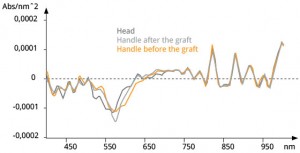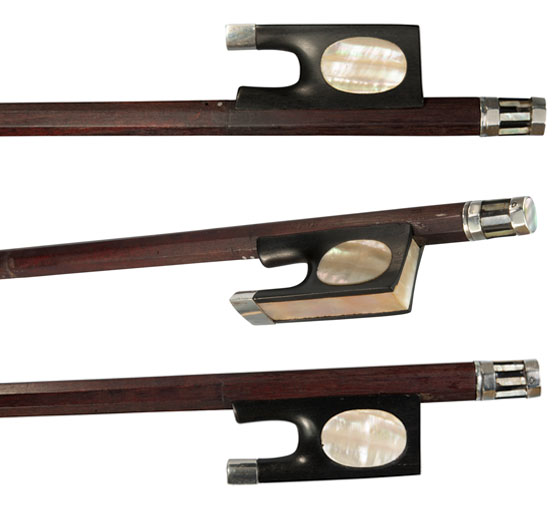Newsletter / September 2013

Nicolas Léonard Tourte (1746 – 1807?)
An examination of a very fine violin bow with original grafting
The bow under examination is a particularly appealing and intriguing specimen of this bowmaker’s work.
Made around 1800, it originates from the master’s final period. It is already “modern” in its design and exhibits all the development features of the mature bow model familiar to us today.
The Stick
The stick is made from superb quality pernambuco, dark red, almost purple in colour, and striking in its powerful elegance. The model of the head is typical N. L. Tourte – the chamfers are pronounced and full of character, if somewhat lacking in elegance.
The Graft
Let us now turn to a special feature of the bow and the essence of this analysis: We have repeatedly encountered bows made by N.L. Tourte in particular, which had been scarfed in various places, mainly underneath the winding. Until now traditional expertise has been unable to recognise and classify this phenomenon correctly. The relatively frequent occurrence of such graftings suggests to us that these are not – as a rule – later repairs but may be explained instead by the rarity of pernambuco wood of this quality and the parsimonious use of the material thus required.
UV/VIS spectroscopy
In an effort to confirm our thesis, and using this bow as our example, we had the two joined parts examined scientifically by way of UV/VIS spectroscopy, to provide an analysis of the organic materials. The results confirmed our supposition:
 Three UV-Vis spectroscopical measurements (handle M1, head M2, stick underneath winding M3) were carried out on the pernambuco stick. In addition to the optical similarity displayed by the two joined pernambuco ends in terms of colour, texture and density, these examinations confirmed a high degree of conformity. The peaks are consistently in the same position within the spectrum. Assumptions regarding the use of wood from the same source are often supported by such spectroscopic conformity.
Three UV-Vis spectroscopical measurements (handle M1, head M2, stick underneath winding M3) were carried out on the pernambuco stick. In addition to the optical similarity displayed by the two joined pernambuco ends in terms of colour, texture and density, these examinations confirmed a high degree of conformity. The peaks are consistently in the same position within the spectrum. Assumptions regarding the use of wood from the same source are often supported by such spectroscopic conformity.
Moreover, the graft was fixed with two sets of four silver pins. With the help of x-ray fluorescence spectroscopy (XRF) it has been possible to furnish clear evidence on the basis of corresponding spectra that these silver pins were made of the same alloy as those found in the silver mountings on the frog and on the adjusting screw. (Silver 93%, copper 6.2%, gold 0.2%, lead 0.3% andzinc 0.3%). The pins are therefore the original ones.
 Given the corresponding spectra, a comparison of all the analyses carried out demonstrates the same composition (silver 93%, copper 6.2%, gold 0.2%, lead 0.3% and zinc 0.3%).
Given the corresponding spectra, a comparison of all the analyses carried out demonstrates the same composition (silver 93%, copper 6.2%, gold 0.2%, lead 0.3% and zinc 0.3%).
Conclusion
Given that the bow discussed also bears the orginal brand stamp TOURTE L, we have clear evidence that this graft is an original one.
While this conclusion is relevant to the financial assessment of the bow it is also crucial for our historical placement of such evidence as experts.
Authors
Stephan Jansen, London / Isaac Salchow, New York City
Scientific Investigations
Brigitte Brandmair, München
Copyright
Isaac Salchow, NYC / Stephan Jansen, London – All Rights Reserved.




